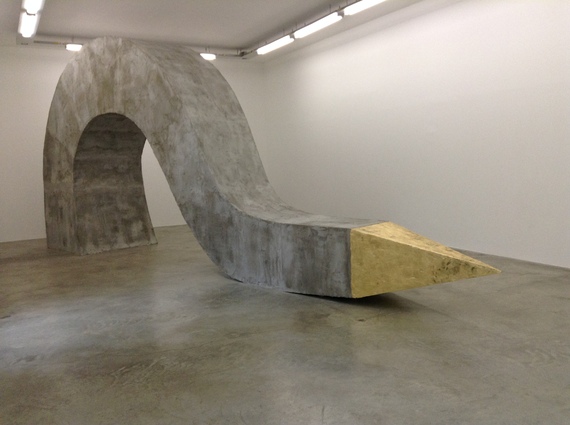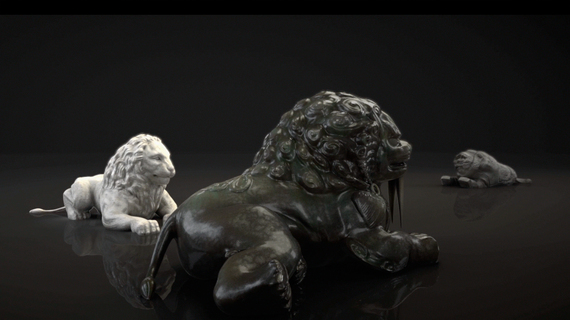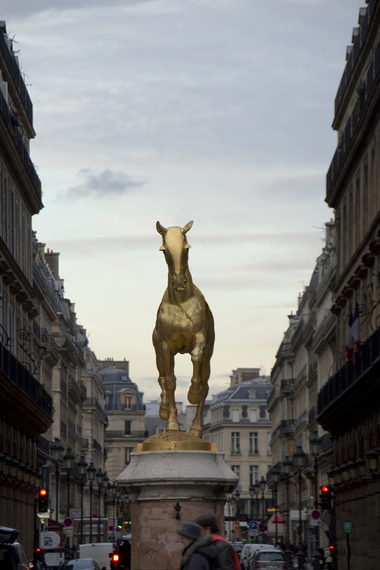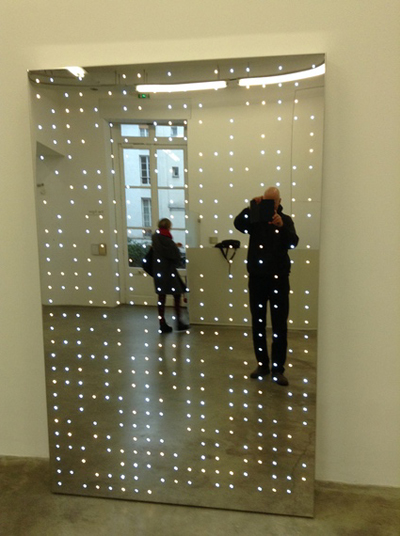Why shouldn't Imperial Lions play like kittens as they make mischief with the world?
And what would happen if all the steel and stone horses that bore our hallowed soldiers, presidents and dictators bolted out from under their riders?
--Photo by Frank Browning
These are but two of the questions that Colombian sculptor, fabricator and video artist Ivan Argote poses in one of the most seductively playful shows I've seen in years, right now at the multi-national Perrotin Gallery in Paris. (Perrotin also has branches in Hong Kong and in Manhattan at 73rd and Madison.).
You enter the Paris Perrotin Gallery, at the edge of the Marais district, and immediately to the right is a flaming monument in Barcelona depicting a Colombian priest trying to convert the natives. To the left is a room-fillinh replica of the obelisk that every tourist has admired at the center of the Place de la Concorde, except this time it's buckled and laying on its side.
"The obelisk is, how to say, impotent," Ivan Argote said with a twinkle as he talked about the fundamental idea behind this show, which he calls Strengthlessness. "He's an impotent obelisk. He doesn't have enough strength to stay erect. Most of the objects in the show are about how power and authority display themselves."
Probably most impressive piece is a 3-D video of monumental lions that roar, play and then limp across the screen in the next room. "It's an idea I kept in the fridge [of his mind] for a long time" Argote said; it came to life only after he found the right animator. His three lions started out as real imperial monuments: one from the Forbidden City in Beijing, another from the Medici collection in Florence, and the third a Babylonian lion from what is now Iraq.
"The lion has become so present in different cultures from Asia to Mesopotamia to ancient Greece. This animal has a lot of violence and strength. So I wanted to transform these lions into kittens and in the 3-D video they are like kittens on their backs playing with balls. It's maybe also about how irresponsible the empires have been, playing with the worlds like they're little toy worlds." The rolling balls, cast of stone and bronze, seem to bear traces of the world's continents.
By video's end, however, the balls persist but the lions, like the obelisk, have lost their power.
Other past and contemporary artists have explored parallel ideas, but often with patent rage. "I feel I'm not there to judge or to be a victim or to be the bad guide. I just try to say how particular people built their stories, but there are many ways to understand it." Ivan Argote, who's only 29 and a graduate of the School of Beaux Arts in Paris, has shown his work in Madrid, Barcelona, London and at the Palais de Tokyo in Paris (France's premier contemporary art museum). In nearly every piece he seems to be winking or even giggling more than screaming.
"I make a negotiation with [the objects representing power] to make them softer, not necessarily to destroy them or fight against them...like with the lions," he said. Last year he spent three months in Barcelona. "Walking around I saw these sort of evangelization scenes. One of them was a priest showing the way to an indigenous Indian and kissing a cross. It was funny because it was in downtown Barcelona, but nobody there cares about it. Even people from Barcelona don't know this monument, so I decided to go at night and have drinks with the statue the way we do with my dad and my granddad back in Bogata. I took some Tequila, and then I burned the statue with a little bit of it, but the Tequila wasn't strong enough, so I had to do it with absinthe. Just a little bit, it did not hurt the statue."
In Madrid, when Argote came across a long alley of statues commemorating the kings of Spain, he started climbing on the stone kings and draping them with South American ponchos until the Madrileno police caught him and ordered him to climb down--but not before he'd documented this sort of very contemporary action art.
Among the cleverest still images are a series of monumental horses without riders, first among them Joan of Arc on her gilded steed, which dominates the Place des Pyramids, in Paris just behind the Louvre, which, you may recall, was the final residence of Louis XVI, prior to his decapitation. Joan is also one of the top Paris tourist destinations--except that in Agorte's version she and her saddle have been removed, leaving the golden horse free of rider. He's made similar images in London and Central Park and Madrid (not all of which are in the show).
He calls the series Horses. "It's like a history of power, how these figures are represented. These equestrian statues give more value to the hero, to the rider. So I erased the guys to show just the horses . . . to show how ridiculous is the way we construct these images, how the way power represents itself is a kind of kitsch. The horse is just a sort of 'frame' for the heroes. I wanted to show just the frame."
The notion of "frame"--or more simply context--of art and power is at the heart of these pieces that take up two floors at the Perrotin gallery. If there is a coda to the work it is masked in the very first room by a large mirror panel of fiber optic dots, which we're told contain a Morse Code version of a line from the late French philosopher Michel Foucault. "Don't ask me who I am or tell me to stay the same: that's a government mentality. It controls documents. It should not infringe on my freedom to write."
Photo by Frank Browning
All images copyright Ivan Argote and Perrotin Gallery unless otherwise noted.




